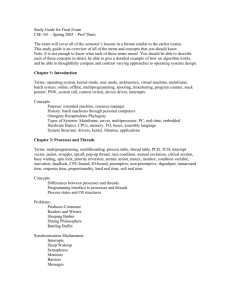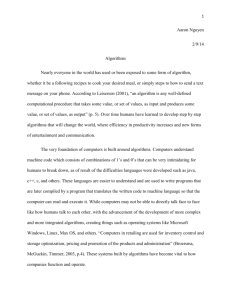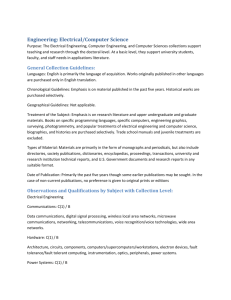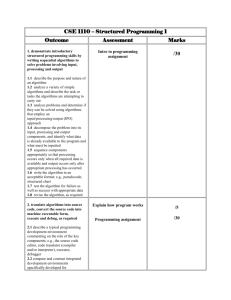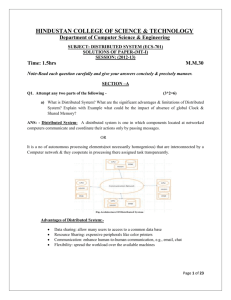detection algorithms
advertisement
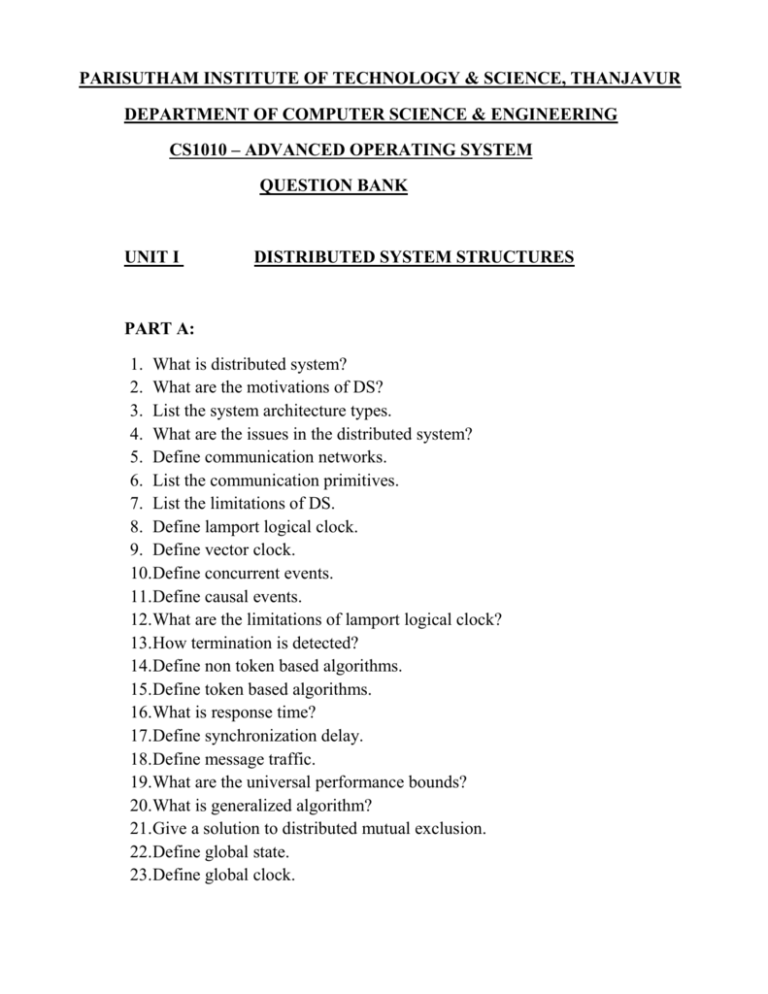
PARISUTHAM INSTITUTE OF TECHNOLOGY & SCIENCE, THANJAVUR DEPARTMENT OF COMPUTER SCIENCE & ENGINEERING CS1010 – ADVANCED OPERATING SYSTEM QUESTION BANK UNIT I DISTRIBUTED SYSTEM STRUCTURES PART A: 1. What is distributed system? 2. What are the motivations of DS? 3. List the system architecture types. 4. What are the issues in the distributed system? 5. Define communication networks. 6. List the communication primitives. 7. List the limitations of DS. 8. Define lamport logical clock. 9. Define vector clock. 10.Define concurrent events. 11.Define causal events. 12.What are the limitations of lamport logical clock? 13.How termination is detected? 14.Define non token based algorithms. 15.Define token based algorithms. 16.What is response time? 17.Define synchronization delay. 18.Define message traffic. 19.What are the universal performance bounds? 20.What is generalized algorithm? 21.Give a solution to distributed mutual exclusion. 22.Define global state. 23.Define global clock. 24.Define shared memory. 25.Define resource management. PART B: 1. Explain the issues in Distributed operating systems. 2. Briefly explain the lamport logical clock & its limitations. 3. Explain about vector clocks. 4. Explain chandy – lamport’s global state recording algorithm. 5. Explain lamport algorithm. 6. Give a detailed explanation on non token based algorithms. 7. Write about Suzuki kasami’s algorithm. 8. Write about raymond’s tree based algorithm. 9. What are the inherent limitations of DS? 10.Write about comparative performance analysis. UNIT II DISTRIBUTED DEADLOCKS PART A: 1. Write on resource Vs communication deadlocks. 2. What is graph theoretical model? 3. Define deadlock prevention. 4. Define deadlock avoidance. 5. Define deadlock detection. 6. What are the issues in deadlock detection & resolution. 7. What is centralized control? 8. What is distributed control? 9. What is hierarchical control? 10.Define the types of deadlock detection algorithms. 11.What are the centralized deadlock detection algorithms? 12.What are the distributed deadlock detection algorithms? 13.Define path pushing algorithm. 14.Define edge chasing algorithm. 15.Write about Mitchell-merritt algorithm. 16.Write about sinha-natarajan algorithm. 17.Define diffusion computation algorithm. 18.Define global state detection algorithm. 19.List the hierarchical deadlock detection algorithms. 20.Define agreement protocols. 21.What is byzantine agreement protocol? 22.What is the solution to byzantine agreement problem? 23.What are the applications to agreement protocol? 24.What are the design issues in distributed file system? 25.What is sprite file system? PART B: 1. Explain the deadlock handling strategies. 2. What are the control organizations for distributed deadlock detection? 3. Explain briefly about centralized deadlock detection algorithms. 4. Explain briefly about distributed deadlock detection algorithms. 5. What are the classifications of agreement protocols? 6. Give the solutions to the byzantine agreement problem. 7. Explain briefly about hierarchical deadlock detection algorithms. 8. Give the architectural representation of distributed resource management. 9. List the mechanisms for building distributed file system. 10.Explain about log structured file system. UNIT III DISTRIBUTED COORDINATION PART A: 1. List the algorithms for DSM. 2. Define memory coherence. 3. What are the various types of consistency? 4. Define write – invalidate protocol. 5. Define write – update protocol. 6. List out the design issues. 7. Define page replacement. 8. What is IVY system? 9. Define coherence protocol. 10.What is munin system? 11.What is mirage system? 12.Define clouds. 13.What are the issues in load distributing algorithm? 14.What are the various load distributing algorithms? 15.What are the various load sharing algorithms? 16.What are the steps to select a load sharing algorithm? 17.What are the requirements for load distributing? 18.What is v system? 19.What is sprite system? 20.What are the issues of task migration? 21.Define location transparency. 22.Classify the failures. 23.Define the kinds of approaches for recovery. 24.Define check points & its types. 25.Define voting protocols. PART B: 1. 2. 3. 4. 5. 6. 7. 8. 9. Explain the components of load distributing algorithms. Give a detailed explanation of load distributing algorithms. Give a detailed explanation of load sharing algorithms. Explain about backwad error recovery techniques. Explain about voting protocols. Briefly explain about static protocol. Briefly explain about dynamic voting protocol. Write about synchronous check pointing & recovery. Write about asynchronous check pointing & recovery. 10.Write about dynamic reassignment protocols. UNIT IV PROTECTION AND SECURITY PART A: 1. Define potential security violations. 2. Classify the violations. 3. Explain external Vs internal security. 4. Explain protection Vs security. 5. What is policies & mechanisms? 6. What are the design principles for secure systems? 7. Define access matrix model. 8. What are the components of matrix model? 9. What are the capabilities of matrix model? 10.Give the advantages of matrix model. 11.Give the drawbacks of matrix model. 12.Define access control list method. 13.Give the implementation considerations. 14.Explain lock key method. 15.What are the advanced models of protection? 16.Define state transition. 17.Define lattice model. 18.Define military security model. 19.What is hydra kernel? 20.Define granularity. 21.Define cryptography. 22.Define conventional cryptography. 23.Define modern cryptography. 24.Define DES. 25.Define digital signatures. PART B: 1. Explain the preliminaries of protection & security. 2. Write about access matrix model. 3. Explain the implementations of access matrix. 4. Give a detailed description about safety in the access matrix model. 5. Write about the advanced models of protection. 6. Explain about private key cryptography. 7. Explain about public key cryptography. 8. Briefly explain about the model of cryptography. 9. Explain about the authentication in distributed systems. 10.Write briefly about Kerberos system. UNIT V MULTIPROCESSOR AND DISTRIBUTED DATABASE PART A: 1. What are the motivations of multiprocessor systems? 2. Explain tightly coupled Vs loosely coupled systems. 3. Compare UMA vs NUMA vs NORMA architectures. 4. Define bus. 5. Define cross-bar switch. 6. Define caching. 7. What is hypercube architecture? 8. Define separate supervisor configuration. 9. Define master-slave configuration. 10.Define symmetric configuration. 11.Give the OS design issues. 12.Define threads. 13.Give thread types. 14.Define user level threads. 15.Define kernel level threads. 16.Define first class threads. 17.What is test & set instruction? 18.Define swap instruction. 19.Define fetch & add instruction of ultra computer. 20.What are the issues in processor scheduling? 21.Define two phase locking (2PL). 22.Define static locking. 23.Define wait & die. 24.Define wound & wait. 25.Define TWR (Thomas write rule). PART B: 1. Explain about threads in detail. 2. Write about process synchronization briefly. 3. Write about processor scheduling briefly. 4. Explain about memory management in mach OS. 5. Write about serializability theory. 6. Explain in brief about distributed database systems. 7. Write about lock based algorithms. 8. Write about timestamp based algorithms. 9. Write about optimistic algorithms. 10. Explain in brief about data replication.
